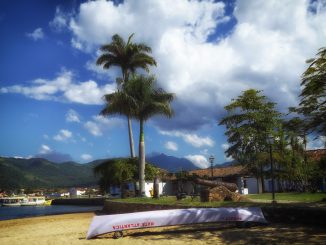
Less than 10 kilometers from the bustling city of Manaus in northern Brazil, the Meeting of the Waters (Encontro das Águas) is a confluence between two Amazon River tributaries, the Rio Negro and the Rio Solimões. The natural phenomenon where the two rivers run side by side without mixing for over 6 km it is only one of the many tourist attractions Manaus and the Amazon river have to offer
This strange attraction occurs because of several different characteristics of each river including, temperature, density, speed of the waters flow, and pH. The Meeting of the Waters is a distinct delineation between the dark tea colored water of the Rio Negro, and the milky café au lait tinted water of the Rio Solimões. The Rio Negros dark water flow is warmer and slower with an average temperature of 28°C and a speed of nearly 2 km per hour. The Rio Solimões with its milky water is colder at 22°C and flows between 4 and 6 km per hour. The Rio Solimões is light and cloudy because it is filled with rich mineral sediment flowing down from the Andes Mountains causing it to be much denser. It is colder because much of the water is the result of snow melt from the high mountain range. The Rio Negro gets its black tea hue because of plant and leaf matter that has decayed and dissolved in the water much like a cup of English Breakfast. The Rio Negro however carries little to no sediment and is considered one of the cleanest natural waters in the world.
Thanks to strong, fast-moving waters downstream the two do eventually mix to become part of the Lower Amazon River. As this region is a tourist destination as well as a means of commerce, there is some artificial mixing before it naturally occurs. Fast moving boats, large boats, and river dolphins pull little bits of the cloudy water into the clear water, giving the impression of milk in coffee before it’s been stirred.
Amazon River Facts
- The Amazon is approximately 6,400 km (4,000 miles) long.
- Portions of the Amazon River flow through Guyana, Ecuador, Venezuela, Bolivia, Brazil, Colombia and Peru.
- During the rainy season parts of the Amazon can react a staggering 190 km (120 miles) in width.
- Manaus is the largest city along the Amazon River with more than 1.5 million people living there.
- More than 3,000 identified species of fish live in the amazon and more are discovered every year.
- 15 million years ago the Amazon ran in the opposite direction (sort of). Before the Andes were fully formed the river flowed into the Pacific ocean instead of the Atlantic where it flows today.
- 12,540,000 cubic meters or water flow through the river every minute.
- 20% of the fresh water on the planet is supplied by the Amazon.
- 30% of flora and fauna on Earth live in the Amazon River and Rainforest.

